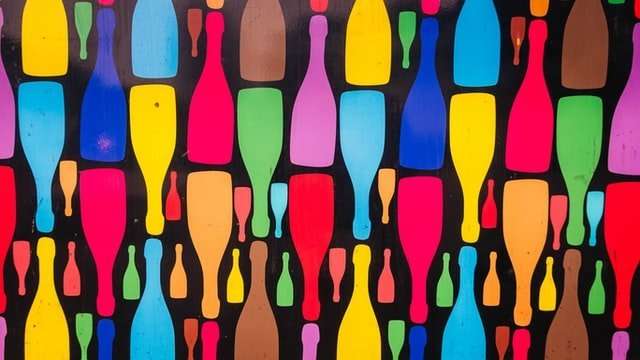Vector art is a graphics file format that uses geometric shapes to represent images. Vector graphics are created with vector software and can be scaled to any size without losing quality. However, unlike raster graphics (such as .jpg’s), vector images do not contain pixels but are drawn using lines and curves.
You can create vector art using a vector application such as Adobe Illustrator (Mac) or Adobe Photoshop (Windows).
Vector art is great for logos, signage, typography, posters, and many other applications. Though the resolution may be low, it can still look good in print because the edges remain clear rather than pixelated.
Vector art also has its limitations. If you want to create realistic artwork with smooth gradients, soft blends, and natural-looking textures, then raster graphics is the better choice.
There are several types of vector art:
1. Flat Vector Art – Shapes that are flat and made up of straight lines only are called flat vectors.
2. Rasterized Vector Art – This type of vector art is converted into pixels by the computer and is not scalable without losing quality. The original outline remains clear while being enlarged but will appear blocky if reduced in size. These files can be very large in size due to
Vector art is an important part of the design world. As a professional designer, you will be required to create some vector art from time to time. It’s a good idea to get in the practice of creating it yourself so that you can better understand how to use what you find online for your projects.
The most common type of vector art is line art. Line art consists of lines and shapes, and nothing else. While this might seem very limiting, there are many different types of line art. Each type has its own unique style and look. You can create everything from complex patterns to simple drawings with just a computer program, a mouse, and a little creativity.
One example of line art is pixel art. Pixel art is exactly what you think it is: small squares of color or black ink on white paper that form pictures or words by their arrangement. This form of art is popular in video games and other places where the artist needs to work within certain limitations to achieve the desired end result.
This type of artwork has been used for many years by professionals as well as hobbyists for various reasons, including: * Disadvantage – Pixel art can take quite some time to produce because it requires much attention to detail, patience, and skill. It’s also
Vector art is any type of digital artwork that contains geometric objects and uses mathematically described curves and lines to represent images in computer graphics. Vector graphics are based on two-dimensional geometric shapes or mathematical formulas, unlike bitmap (or raster) graphics that use an array of dots, or pixels. Computer programs such as Adobe Illustrator, Flash and Inkscape are capable of creating vector graphics.
A little history:
Vector drawing was originally developed by engineers for creating technical illustrations such as engineering drawings and electrical circuit diagrams. The idea was to use a device called a plotter to draw lines in ink instead of using a pen or pencil, but the same basic principles can be applied to software.
To create the look of a black-and-white line drawing, the artist must create two separate sets of instructions. The first set indicates the path along which the line will be drawn; the second set indicates the width of the line at any point along its length. Because each line can be manipulated as an independent object, rather than as part of a larger area, vector art can produce complex shading effects by manipulating these two sets of instructions separately. By varying these two parameters according to an algorithm—known as a Bézier curve—the artist can determine how
Vector art is a type of digital art that has more in common with geometry than it does with computer graphics.
Vector art is created by using mathematical formulas to determine the placement and shape of lines, curves, and shapes such as circles, squares, triangles, and stars. Vector art can be drawn on a vector graphics editor or created in Adobe Illustrator using the pen tool.
Vector art is used in logos and graphic designs because of its clean, crisp look. Vector art can be scaled without losing any detail because it is drawn with mathematical formulas. Any type of line can be used in vector art drawing—straight lines, curved lines, thick lines, thin lines…** __https://en.wikipedia.org/wiki/Vector_art
vector art is a graphic design that uses mathematical algorithms to generate images. They are highly scalable and resolution-independent, meaning they can be enlarged or reduced in size with minimal loss of fidelity. This can make them especially useful for logos, line art, and other graphics where clean, sharp lines and exact shapes are required. Vector graphics were traditionally created in illustration software by drawing polygons and curves with tools like the pen tool, but this is becoming less common as raster image software has developed the ability to create vector graphics directly
Vector art is a form of digital art based on mathematical expressions (vectors) rather than on the locations of pixels. Vector graphics are resolution-independent, meaning that they can scale to any size without loss of quality, in contrast to raster graphics, which cannot scale up beyond the resolution of a pixel-based image. Vector graphics are commonly found in logos, line art, drawings, app icons, complex illustrations and typography.
The term “vector graphics” may refer to both the artwork itself and the medium by which it is rendered (as opposed to bitmap graphics). It may also be used as a verb to describe the process of creating vector graphics.
Vector graphics are based on vectors, which lead through locations called control points or nodes. The earliest computer vector graphic was perhaps the 1962 star plot from Project Vanguard. Inkscape describes SVG files as “scalable vector graphics”, suggesting that vector graphics are only created from scalable outlines.
To create vector images from raster images certain interpolation techniques are used to calculate values at points between existing pixels (see Bresenham’s line algorithm). There are many paths to accomplish this task; some methods use iterative processes such as bicubic splines or Lagrange Interpolation; some
Vector art is a form of digital illustration made up of geometric shapes. It is the most common form of illustration used by professional designers. Vector art is scalable and can be used at any resolution and color depth without loss of detail. There are several types of vector art, each with its own benefits and uses.
According to Wikipedia there are three main categories: Pixel Art, Raster Art, and Vector Art.
Pixel Art is any image that consists of pixels, or square blocks, or dots depending on how you want to refer to them. The primary benefit for pixel art is that it can be scaled without losing definition. Pixel art has a limited color palette as well as limited detail definition.
Vector Art refers to images with elements that have distinct paths and points. They have a much larger range of colors than pixel art, but they also tend to have less detail than pixel art. Vector art can be scaled indefinitely without loss of definition.*
Raster Art is a bit different than the previous two forms in that the lines are not sharp angles, but rather soft curves. While this may seem less precise than vector art, it actually has more detail definition than Pixel or Vector art due to the softness of the lines. Raster art also has a larger color palette


